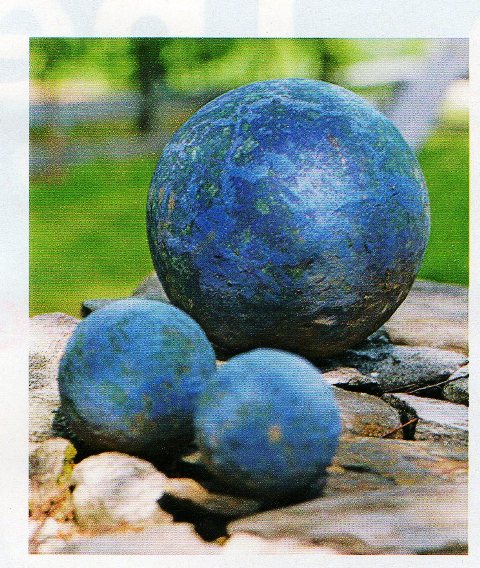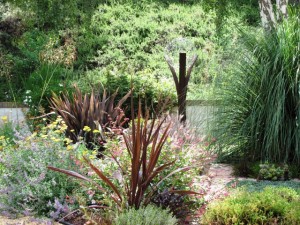
Tempest holds a stainless-steel Mesh orb in its arms. The piece measures 70 inches tall.
As a follow-up to my last post about round objects in the landscape, I thought I’d show off a few more of my spherical works of art, from my backyard. You can see how appealing it is to start with a shape and then repeat it often. Some of the orbs in my garden are more obvious than others. One of the round forms is quite subtle. It is part of a sculpture called “Tempest” by my friend Jennifer Asher and her collaborator-fabricator Mario Lopez.
Jennifer owns TerraSculpture with Karen Neill Tarnowski and the two women never cease to amaze me at their innovation and talent. These pieces fill a void in the outdoor sculpture world – bringing contemporary sculpture to the residential setting at far below the huge price tags you usually see.
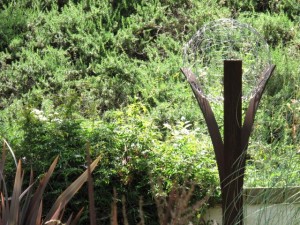
Tempest, closer up
TerraSculpture originally created Tempest in a powder-coated bright orange finish. My husband Bruce was interested in the piece but suggested that we have Jennifer and Mario make the base in weathered steel, which somehow fits our style better.
I love the shape of the base – three “arms” join together and then gradually open to cradle a stainless steel mesh ball. The weathered steel (some might call it “rust”) echoes the dark burgundy-rust blades of my garden’s New Zealand flax and Cordyline plants. There’s something really wonderful about the piece’s see-through quality, too. Upon seeing “Tempest” standing in our garden, visitors are likely to utter a gasp of delight, followed by the immediate question: Where did you find that awesome piece?
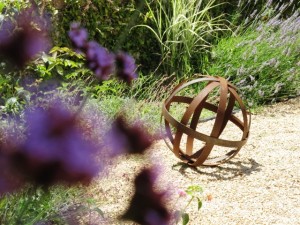
My weathered steel orb - a pretty object in the garden.
More steel – also rusted – appears in the 24-inch orb I purchased from my friends Annette Gutierrez and Mary Gray of Pot-ted in Los Angeles. I’ve shown earlier pics of their tangerine and aqua-finished objects.
For me, the weathered steel works well with everything else in my garden. See how pretty this piece looks on the “California Gold” crushed gravel? On the other hand, if Annette and Mary ever decide to make their metal orb series in lime green, I will be the first in line to snag a small-medium-large trio!
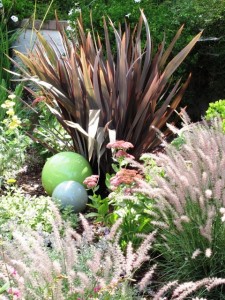
The perennial bed is dotted with orbs, from Bauer Pottery
And what about those awesome Bauer balls? I think I have six of them (it’s an ever-changing number). Here are two of them, looking nice and settled-in at the base of a New Zealand flax. These Bauer glazes are called Lime Green (15 inch size) and French Blue (8-inch size).
The glossy finish and classic round forms add up to nothing short of stunning, especially when surrounded by foliage, flowers and ornamental grass plumes.
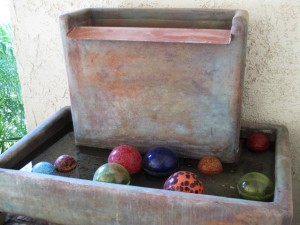
Colorful glass floats add a lot of character to this fountain.
I have a thing for floating glass balls, too. Here is a little cluster of them, floating in the fountain on our entry porch. There are several glass artists who make these decorative balls. You can usually find the artists and their wares at major flower shows.
One of my favorite sources is Glass Gardens NW. Owner-artist Barbara Sanderson makes a rainbow of glass floats and orbs, as well as larger sculpture pieces for the garden. Check her out!
Finally, the garden has curves of a more organic nature – and that is in the outline of two crescent-shaped perennial beds. With so much linear geometry in my backyard (the horizontal lines of the house, patio, pergola, wall and pathways) it’s nice to visually break up these forms with sinuous curves.
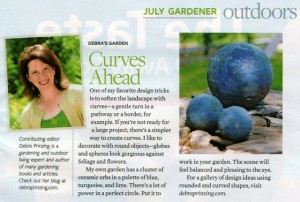 Last summer, I wrote a little piece about using orbs in the garden. Better Homes & Gardens illustrated the words with a photo depicting a trio of concrete spheres that looked like they were stained a denim blue color. Really pretty.
Last summer, I wrote a little piece about using orbs in the garden. Better Homes & Gardens illustrated the words with a photo depicting a trio of concrete spheres that looked like they were stained a denim blue color. Really pretty.








